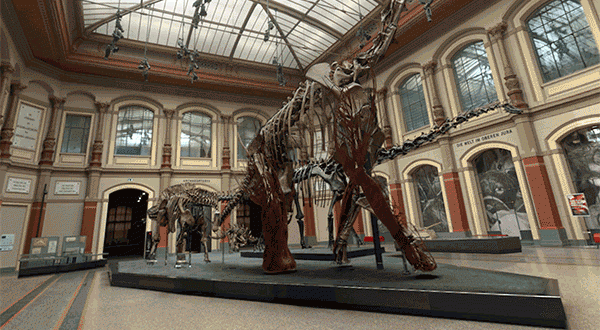Many millions of years ago, dinosaurs ruled the Earth and sea dragons were not just Hollywood creations, but fearsome predators that stalked the oceans. It’s a world that vanished long ago, but one that continues to fascinate those seeking to understand the origins of life on our planet.
Starting today, anyone, anywhere can explore this world on
We wanted to give you a glimpse of how these colossal creatures actually looked. So we worked with ecologists, paleontologists and biologists to put virtual skin and flesh on the preserved skeletons. From the size of the eye to the position of the snout and the bend of the neck, the texture and creases of the skin were all painstakingly recreated, and verified by a team of scientists. For the best experience, use a viewer like Google Cardboard to look the beast in the eye.
In addition to the VR experiences, this global exhibition of natural history has plenty more for experts and armchair explorers alike:
- Turn back time by 4.6 billion years with the help of the Natural History Museum by scrolling through the history of life from the origins of the solar system, through the rise and the fall of prehistoric worlds.
- See the giant sloth jaw that led Darwin to his groundbreaking theory of natural selection.
- Explore the diversity of nature from the Lion fish to the Paradise Birdwing and learn from birds about the art of flirting.
- View 3,000 species on display in one giant cabinet or find out how our own predecessors may have looked.
- With Street View, walk around dinosaurs in New York, explore 30+ natural history museums from to Australia to Russia and even go underwater with turtles in Brazil.
- Join YouTube’s Vsauce2 to discover the story of Martha, the last passenger pigeon.
The free collection opens today at g.co/naturalhistory and through the Google Arts & Culture mobile app on iOS and Android. And if you’re a teacher, there are more than 20 new Google Expeditions waiting for you and your classroom to discover. We hope you enjoy this journey through the history of nature as much as we do.
Posted by Amit Sood, Director of the Google Cultural Institute https://3.bp.blogspot.com/-yQoDsqVHEUY/V9cc-KEwxyI/AAAAAAAAS74/z5cylfCXQcYt6jm54mssXq03UVBB7yhjQCLcB/s1600/Screen%2BShot%2B2016-09-12%2Bat%2B2.23.37%2BPM.png Amit Sood Director of the Google Cultural Institute Google –> <!– INSTRUCTIONS Enter info below to be used in google.com/about site blog syndication. Leave elements empty if there is no valid data. Example: https://4.bp.blogspot.com/-OrWKGo-aTQA/V9cZ1FwbHxI/AAAAAAAAS7s/fx6InErDakE5OxLx6OAPkbCzEReXiizBgCLcB/s1600/Natural%2BHistory%2BGoogle%2BArtsCulture_Dinosaur.gif Amit Sood Director of the Google Cultural Institute Google –>

